CHCECE001 & CHCDIV002: Cultural Competence & Safety in Early Childhood
VerifiedAdded on 2023/06/15
|68
|11929
|205
Homework Assignment
AI Summary
This assignment focuses on developing cultural competence and promoting Aboriginal and/or Torres Strait Islander cultural safety within an early childhood education context. It covers key elements from units CHCECE001 and CHCDIV002, including reflecting on cultural identity, identifying cultural safety issues, and creating inclusive learning environments. The assignment requires students to engage with readings from the Early Years Learning Framework and other relevant resources to answer questions related to diversity, cultural competence, and strategies for building relationships with families from diverse backgrounds. Specific tasks involve listing guiding principles, defining cultural competence, identifying keywords in the EYLF, and suggesting ways educators can promote respect for diversity and create welcoming spaces for families with English as a second language. The overall aim is to equip early childhood educators with the knowledge and skills to work effectively with children from all cultural backgrounds.

CHCECE001 Develop cultural competence and CHCDIV002 Promote Aboriginal and/or Torres Strait Islander cultural safety. Theory Tasks.
CHCECE001
Develop cultural competence
CHCDIV002
Promote Aboriginal and/or Torres Strait
Islander cultural safety
Theory Assessment Task
Unit Purpose
This unit co-assesses CHCECE001 and CHCDIV002.
The assessment tasks within this unit provide you with the opportunity to demonstrate evidence of the
knowledge and skills required to enable you to work with Aboriginal and Torres Strait Islander people,
including identifying cultural safety issues in the workplace, modelling cultural safety in your own work
practices and developing strategies to enhance cultural safety.
The assessment tasks also provide you with the opportunity to demonstrate evidence of the required
knowledge and skills to address duty of care requirements as well as work within an ethical framework, and
apply relevant legislation, policies and procedures in responding to children and young people.
Elements – CHCECE001 Develop cultural competence
The following elements define the essential outcomes of this unit: Element 1 Reflect on own cultural identity and biases Element 2 Identify and develop cultural competency Element 3 Research Aboriginal and/or Torres Strait Islander communities Element 4 Support individual cultural identities Element 5 Create environments to support children’s cross-cultural understanding and relationships Element 6 Support the implementation of inclusive learning experiences Element 7 Support children in developing confidence and strength in personal and cultural identity
1
Early Childhood Education and Care. © ICCC Resources 2015.V4.
CHCECE001
Develop cultural competence
CHCDIV002
Promote Aboriginal and/or Torres Strait
Islander cultural safety
Theory Assessment Task
Unit Purpose
This unit co-assesses CHCECE001 and CHCDIV002.
The assessment tasks within this unit provide you with the opportunity to demonstrate evidence of the
knowledge and skills required to enable you to work with Aboriginal and Torres Strait Islander people,
including identifying cultural safety issues in the workplace, modelling cultural safety in your own work
practices and developing strategies to enhance cultural safety.
The assessment tasks also provide you with the opportunity to demonstrate evidence of the required
knowledge and skills to address duty of care requirements as well as work within an ethical framework, and
apply relevant legislation, policies and procedures in responding to children and young people.
Elements – CHCECE001 Develop cultural competence
The following elements define the essential outcomes of this unit: Element 1 Reflect on own cultural identity and biases Element 2 Identify and develop cultural competency Element 3 Research Aboriginal and/or Torres Strait Islander communities Element 4 Support individual cultural identities Element 5 Create environments to support children’s cross-cultural understanding and relationships Element 6 Support the implementation of inclusive learning experiences Element 7 Support children in developing confidence and strength in personal and cultural identity
1
Early Childhood Education and Care. © ICCC Resources 2015.V4.
Paraphrase This Document
Need a fresh take? Get an instant paraphrase of this document with our AI Paraphraser
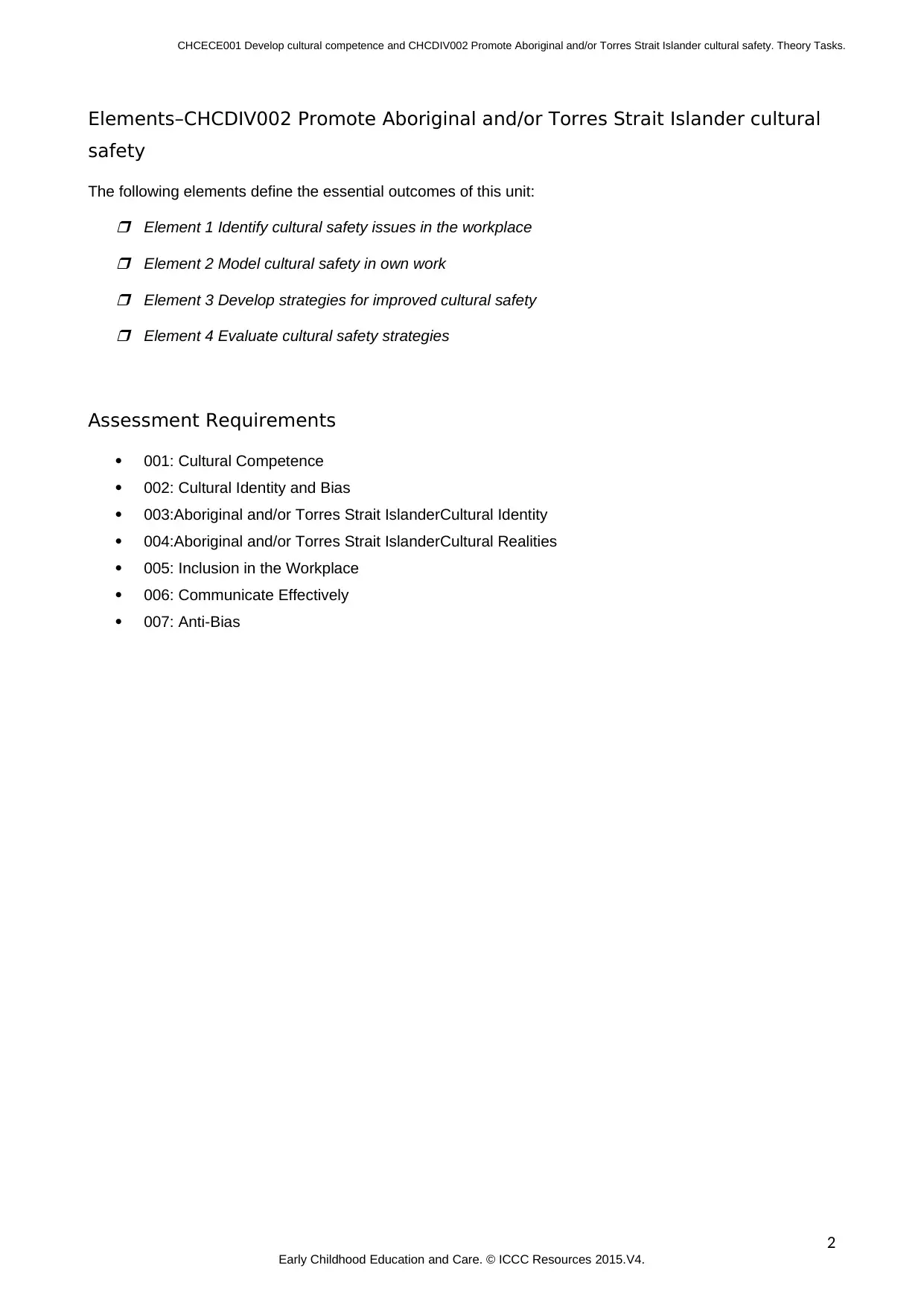
CHCECE001 Develop cultural competence and CHCDIV002 Promote Aboriginal and/or Torres Strait Islander cultural safety. Theory Tasks.
Elements–CHCDIV002 Promote Aboriginal and/or Torres Strait Islander cultural
safety
The following elements define the essential outcomes of this unit: Element 1 Identify cultural safety issues in the workplace Element 2 Model cultural safety in own work Element 3 Develop strategies for improved cultural safety Element 4 Evaluate cultural safety strategies
Assessment Requirements
001: Cultural Competence
002: Cultural Identity and Bias
003:Aboriginal and/or Torres Strait IslanderCultural Identity
004:Aboriginal and/or Torres Strait IslanderCultural Realities
005: Inclusion in the Workplace
006: Communicate Effectively
007: Anti-Bias
2
Early Childhood Education and Care. © ICCC Resources 2015.V4.
Elements–CHCDIV002 Promote Aboriginal and/or Torres Strait Islander cultural
safety
The following elements define the essential outcomes of this unit: Element 1 Identify cultural safety issues in the workplace Element 2 Model cultural safety in own work Element 3 Develop strategies for improved cultural safety Element 4 Evaluate cultural safety strategies
Assessment Requirements
001: Cultural Competence
002: Cultural Identity and Bias
003:Aboriginal and/or Torres Strait IslanderCultural Identity
004:Aboriginal and/or Torres Strait IslanderCultural Realities
005: Inclusion in the Workplace
006: Communicate Effectively
007: Anti-Bias
2
Early Childhood Education and Care. © ICCC Resources 2015.V4.

CHCECE001 Develop cultural competence and CHCDIV002 Promote Aboriginal and/or Torres Strait Islander cultural safety. Theory Tasks.
Required Readings
In order to complete this unit of competency you are required to access the following key resources.
Textbook
Kearns, K. (2014). The Big Picture: Working in Early Childhood Education and Care Series (3rd
ed.). Victoria: Cengage Learning Australia.
Core Documents Belonging, Being and Becoming: The Early Years Learning Framework for Australia. (2009).
Australian Government Department of Education, Employment and Workplace Relations.
Canberra: DEEWR.
Code of Ethics. (2014). Early Childhood Australia. Retrieved
from:http://www.earlychildhoodaustralia.org.au/wp-content/uploads/2014/07/
code_of_ethics_brochure_print_2010.pdf
Additional Readings for this Unit
Aboriginal Cultural Competence Framework: Culture and the child and family services system.
(2008).Retrievedfrom:
http://www.dhs.vic.gov.au/__data/assets/pdf_file/0011/580934/Aboriginal_cultural_competenc
e_2008.pdf
Aboriginal and Torres Strait Islander Children’s Cultural Needs. (2012). SNAICC. Retrieved
from:http://www.snaicc.org.au/_uploads/rsfil/02932.pdf
Aboriginal and Torres Strait Islander: Social and Emotional Wellbeing. (2005). Commonwealth of
Australia. Response ability. Retrieved from:
http://www.responseability.org/__data/assets/pdf_file/0007/4795/Aboriginal-and-Torres-Strait-
Islander-Social-and-Emotional-Wellbeing.pdf
Australia – A national overview. Bringing Them Home. Australian Human Rights Commission.
(2010).Retrieved from: https://www.humanrights.gov.au/sites/default/files/content/education/
bringing_them_home/Individual%20resources%20and%20activities/
10_RS_Australia_overview.pdf
Becoming culturally competent – ideas that support practice. (2013).NQS PLP e-Newsletter No. 65.
Retrieved from: http://www.earlychildhoodaustralia.org.au/nqsplp/wp-content/uploads/
2013/10/NQS_PLP_E-Newsletter_No65.pdf (Accessed April, 2015).
Cultural Connections Booklet. (2009).Child Australia. Professional Support Coordinator. Northern
Territory. Retrieved from: https://childaustralia.org.au/Documents/IPSP-Section/Resource-
Centre-Docs/cultural-book-complete-WEB.aspx(Accessed April, 2015).
3
Early Childhood Education and Care. © ICCC Resources 2015.V4.
Required Readings
In order to complete this unit of competency you are required to access the following key resources.
Textbook
Kearns, K. (2014). The Big Picture: Working in Early Childhood Education and Care Series (3rd
ed.). Victoria: Cengage Learning Australia.
Core Documents Belonging, Being and Becoming: The Early Years Learning Framework for Australia. (2009).
Australian Government Department of Education, Employment and Workplace Relations.
Canberra: DEEWR.
Code of Ethics. (2014). Early Childhood Australia. Retrieved
from:http://www.earlychildhoodaustralia.org.au/wp-content/uploads/2014/07/
code_of_ethics_brochure_print_2010.pdf
Additional Readings for this Unit
Aboriginal Cultural Competence Framework: Culture and the child and family services system.
(2008).Retrievedfrom:
http://www.dhs.vic.gov.au/__data/assets/pdf_file/0011/580934/Aboriginal_cultural_competenc
e_2008.pdf
Aboriginal and Torres Strait Islander Children’s Cultural Needs. (2012). SNAICC. Retrieved
from:http://www.snaicc.org.au/_uploads/rsfil/02932.pdf
Aboriginal and Torres Strait Islander: Social and Emotional Wellbeing. (2005). Commonwealth of
Australia. Response ability. Retrieved from:
http://www.responseability.org/__data/assets/pdf_file/0007/4795/Aboriginal-and-Torres-Strait-
Islander-Social-and-Emotional-Wellbeing.pdf
Australia – A national overview. Bringing Them Home. Australian Human Rights Commission.
(2010).Retrieved from: https://www.humanrights.gov.au/sites/default/files/content/education/
bringing_them_home/Individual%20resources%20and%20activities/
10_RS_Australia_overview.pdf
Becoming culturally competent – ideas that support practice. (2013).NQS PLP e-Newsletter No. 65.
Retrieved from: http://www.earlychildhoodaustralia.org.au/nqsplp/wp-content/uploads/
2013/10/NQS_PLP_E-Newsletter_No65.pdf (Accessed April, 2015).
Cultural Connections Booklet. (2009).Child Australia. Professional Support Coordinator. Northern
Territory. Retrieved from: https://childaustralia.org.au/Documents/IPSP-Section/Resource-
Centre-Docs/cultural-book-complete-WEB.aspx(Accessed April, 2015).
3
Early Childhood Education and Care. © ICCC Resources 2015.V4.
⊘ This is a preview!⊘
Do you want full access?
Subscribe today to unlock all pages.

Trusted by 1+ million students worldwide
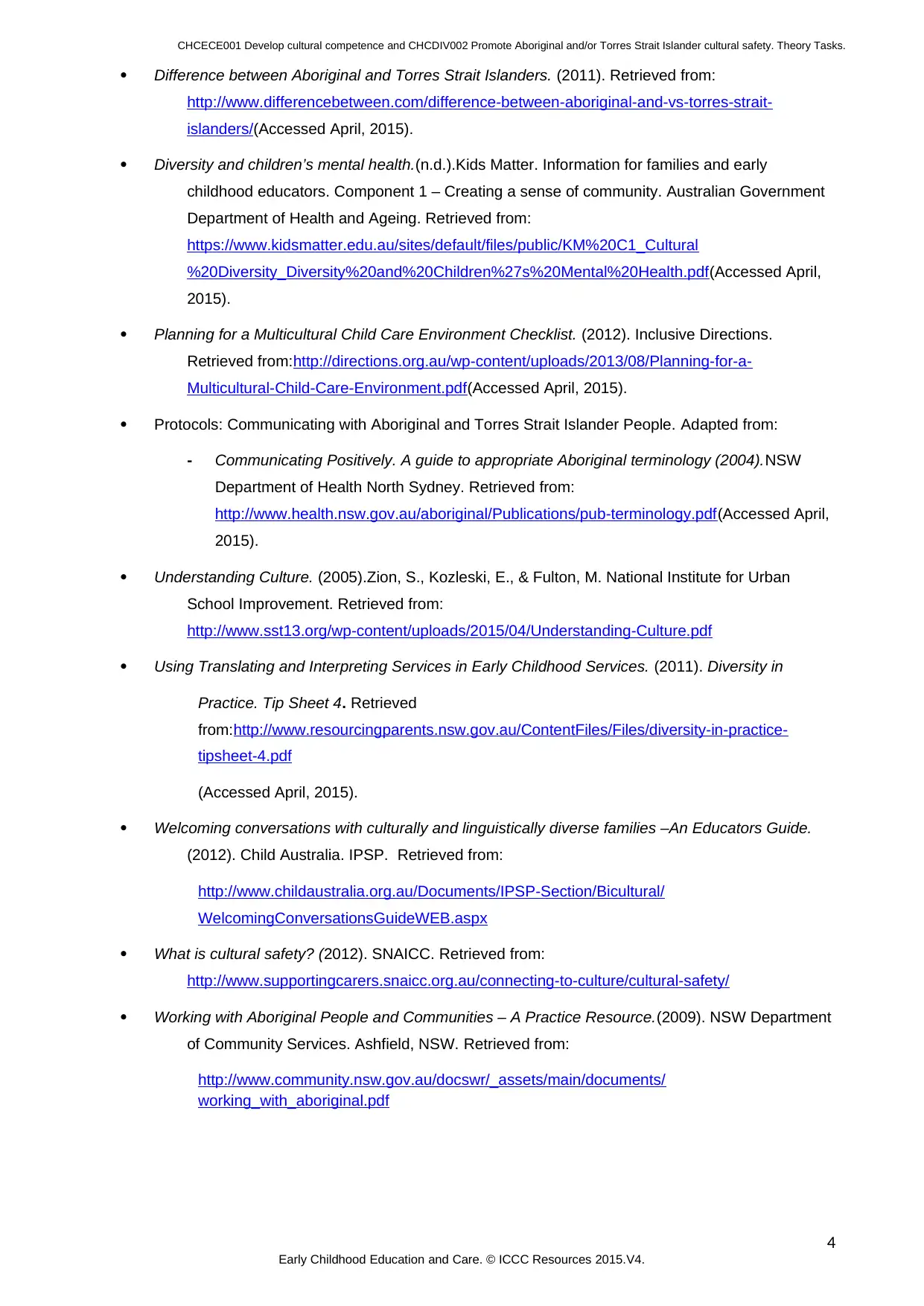
CHCECE001 Develop cultural competence and CHCDIV002 Promote Aboriginal and/or Torres Strait Islander cultural safety. Theory Tasks.
Difference between Aboriginal and Torres Strait Islanders. (2011). Retrieved from:
http://www.differencebetween.com/difference-between-aboriginal-and-vs-torres-strait-
islanders/(Accessed April, 2015).
Diversity and children’s mental health.(n.d.).Kids Matter. Information for families and early
childhood educators. Component 1 – Creating a sense of community. Australian Government
Department of Health and Ageing. Retrieved from:
https://www.kidsmatter.edu.au/sites/default/files/public/KM%20C1_Cultural
%20Diversity_Diversity%20and%20Children%27s%20Mental%20Health.pdf(Accessed April,
2015).
Planning for a Multicultural Child Care Environment Checklist. (2012). Inclusive Directions.
Retrieved from:http://directions.org.au/wp-content/uploads/2013/08/Planning-for-a-
Multicultural-Child-Care-Environment.pdf(Accessed April, 2015).
Protocols: Communicating with Aboriginal and Torres Strait Islander People. Adapted from:
- Communicating Positively. A guide to appropriate Aboriginal terminology (2004).NSW
Department of Health North Sydney. Retrieved from:
http://www.health.nsw.gov.au/aboriginal/Publications/pub-terminology.pdf(Accessed April,
2015).
Understanding Culture. (2005).Zion, S., Kozleski, E., & Fulton, M. National Institute for Urban
School Improvement. Retrieved from:
http://www.sst13.org/wp-content/uploads/2015/04/Understanding-Culture.pdf
Using Translating and Interpreting Services in Early Childhood Services. (2011). Diversity in
Practice. Tip Sheet 4. Retrieved
from:http://www.resourcingparents.nsw.gov.au/ContentFiles/Files/diversity-in-practice-
tipsheet-4.pdf
(Accessed April, 2015).
Welcoming conversations with culturally and linguistically diverse families –An Educators Guide.
(2012). Child Australia. IPSP. Retrieved from:
http://www.childaustralia.org.au/Documents/IPSP-Section/Bicultural/
WelcomingConversationsGuideWEB.aspx
What is cultural safety? (2012). SNAICC. Retrieved from:
http://www.supportingcarers.snaicc.org.au/connecting-to-culture/cultural-safety/
Working with Aboriginal People and Communities – A Practice Resource.(2009). NSW Department
of Community Services. Ashfield, NSW. Retrieved from:
http://www.community.nsw.gov.au/docswr/_assets/main/documents/
working_with_aboriginal.pdf
4
Early Childhood Education and Care. © ICCC Resources 2015.V4.
Difference between Aboriginal and Torres Strait Islanders. (2011). Retrieved from:
http://www.differencebetween.com/difference-between-aboriginal-and-vs-torres-strait-
islanders/(Accessed April, 2015).
Diversity and children’s mental health.(n.d.).Kids Matter. Information for families and early
childhood educators. Component 1 – Creating a sense of community. Australian Government
Department of Health and Ageing. Retrieved from:
https://www.kidsmatter.edu.au/sites/default/files/public/KM%20C1_Cultural
%20Diversity_Diversity%20and%20Children%27s%20Mental%20Health.pdf(Accessed April,
2015).
Planning for a Multicultural Child Care Environment Checklist. (2012). Inclusive Directions.
Retrieved from:http://directions.org.au/wp-content/uploads/2013/08/Planning-for-a-
Multicultural-Child-Care-Environment.pdf(Accessed April, 2015).
Protocols: Communicating with Aboriginal and Torres Strait Islander People. Adapted from:
- Communicating Positively. A guide to appropriate Aboriginal terminology (2004).NSW
Department of Health North Sydney. Retrieved from:
http://www.health.nsw.gov.au/aboriginal/Publications/pub-terminology.pdf(Accessed April,
2015).
Understanding Culture. (2005).Zion, S., Kozleski, E., & Fulton, M. National Institute for Urban
School Improvement. Retrieved from:
http://www.sst13.org/wp-content/uploads/2015/04/Understanding-Culture.pdf
Using Translating and Interpreting Services in Early Childhood Services. (2011). Diversity in
Practice. Tip Sheet 4. Retrieved
from:http://www.resourcingparents.nsw.gov.au/ContentFiles/Files/diversity-in-practice-
tipsheet-4.pdf
(Accessed April, 2015).
Welcoming conversations with culturally and linguistically diverse families –An Educators Guide.
(2012). Child Australia. IPSP. Retrieved from:
http://www.childaustralia.org.au/Documents/IPSP-Section/Bicultural/
WelcomingConversationsGuideWEB.aspx
What is cultural safety? (2012). SNAICC. Retrieved from:
http://www.supportingcarers.snaicc.org.au/connecting-to-culture/cultural-safety/
Working with Aboriginal People and Communities – A Practice Resource.(2009). NSW Department
of Community Services. Ashfield, NSW. Retrieved from:
http://www.community.nsw.gov.au/docswr/_assets/main/documents/
working_with_aboriginal.pdf
4
Early Childhood Education and Care. © ICCC Resources 2015.V4.
Paraphrase This Document
Need a fresh take? Get an instant paraphrase of this document with our AI Paraphraser

CHCECE001 Develop cultural competence and CHCDIV002 Promote Aboriginal and/or Torres Strait Islander cultural safety. Theory Tasks.
Recommended Websites
NAIDOC: http://www.naidoc.org.au/about
National Aboriginal and Torres Strait Islander Children’s Day: http://aboriginalchildrensday.com.au/
Timeanddate.com: http://www.timeanddate.com/holidays/australia/national-sorry-day
Assessment Instructions
Students are required to provide appropriate responses to the indicated questions.
Assessment Outcomes
The Early Childhood Education and Care training packages are vocational qualifications that are competency
based. For each assessment undertaken you will be assessed as Satisfactory, Not Yet Satisfactory or
Incomplete. Where students are assessed as ‘Not Yet Satisfactory’ or ‘Incomplete’ the trainer/assessor will
provide the student with feedback and guidance regarding what needs to be completed for resubmission.
Student Appeals
Students have the right to appeal an unfavourable decision or finding during assessment. All students
appeals must be made in writing using the Appeals Form and specify the particulars of the decision or finding
in dispute. Appeals must be lodged within 28 days of the decision or finding.
5
Early Childhood Education and Care. © ICCC Resources 2015.V4.
Recommended Websites
NAIDOC: http://www.naidoc.org.au/about
National Aboriginal and Torres Strait Islander Children’s Day: http://aboriginalchildrensday.com.au/
Timeanddate.com: http://www.timeanddate.com/holidays/australia/national-sorry-day
Assessment Instructions
Students are required to provide appropriate responses to the indicated questions.
Assessment Outcomes
The Early Childhood Education and Care training packages are vocational qualifications that are competency
based. For each assessment undertaken you will be assessed as Satisfactory, Not Yet Satisfactory or
Incomplete. Where students are assessed as ‘Not Yet Satisfactory’ or ‘Incomplete’ the trainer/assessor will
provide the student with feedback and guidance regarding what needs to be completed for resubmission.
Student Appeals
Students have the right to appeal an unfavourable decision or finding during assessment. All students
appeals must be made in writing using the Appeals Form and specify the particulars of the decision or finding
in dispute. Appeals must be lodged within 28 days of the decision or finding.
5
Early Childhood Education and Care. © ICCC Resources 2015.V4.

CHCECE001 Develop cultural competence and CHCDIV002 Promote Aboriginal and/or Torres Strait Islander cultural safety. Theory Tasks.
001 Cultural Competence
CHCECE001 Develop cultural competence and CHCDIV002Promote Aboriginal and/
or Torres Strait Islander cultural safety
CHCECE001 Develop cultural competence
Element 1 Reflect on own cultural identity and biases
Element 2 Identify and develop cultural competency
Element 3 Research Aboriginal and/or Torres Strait Islander communities
Element 4 Support individual cultural identities
Element 5 Create environments to support children’s cross-cultural understanding and relationships
Element 6 Support the implementation of inclusive learning experiences
Element 7 Support children in developing confidence and strength in personal and cultural identity
Performance Evidence
Knowledge Evidence
CHCDIV002 Promote Aboriginal and/or Torres Strait Islandercultural safety
Element 1 Identify cultural safety issues in the workplace
Element 2 Model cultural safety in own work
Element 3 Develop strategies for improved cultural safety
Knowledge Evidence
Question 1
To complete this task refer to your reading: Becoming culturally competent – ideas that support practice.
a) List the guiding principles of the National Quality Framework (NQF) making explicit attention
to diversity as a matter of principle, policy and action.
The guiding principle on EQUITY, INCLUSION AND DIVERSITY UNDERPIN THE FRAMEWORK
states that it is the capacity of all children to succeed in their learning process, regardless of their
diverse backgrounds and circumstances. The principle acknowledges inclusion of diverse
children. is acknowledged as an approach where diversity is celebrated. It also states that all
educators should demonstrate an equitable and responsive support towards the children.
Furthermore, the principle on AUSTRALIA’S ABORIGINAL AND TORRES STRAIT ISLANDER
CULTURES ARE VALUED mentions that educators should value and respect diversity of all
children (SNAICC, 2012).
6
Early Childhood Education and Care. © ICCC Resources 2015.V4.
001 Cultural Competence
CHCECE001 Develop cultural competence and CHCDIV002Promote Aboriginal and/
or Torres Strait Islander cultural safety
CHCECE001 Develop cultural competence
Element 1 Reflect on own cultural identity and biases
Element 2 Identify and develop cultural competency
Element 3 Research Aboriginal and/or Torres Strait Islander communities
Element 4 Support individual cultural identities
Element 5 Create environments to support children’s cross-cultural understanding and relationships
Element 6 Support the implementation of inclusive learning experiences
Element 7 Support children in developing confidence and strength in personal and cultural identity
Performance Evidence
Knowledge Evidence
CHCDIV002 Promote Aboriginal and/or Torres Strait Islandercultural safety
Element 1 Identify cultural safety issues in the workplace
Element 2 Model cultural safety in own work
Element 3 Develop strategies for improved cultural safety
Knowledge Evidence
Question 1
To complete this task refer to your reading: Becoming culturally competent – ideas that support practice.
a) List the guiding principles of the National Quality Framework (NQF) making explicit attention
to diversity as a matter of principle, policy and action.
The guiding principle on EQUITY, INCLUSION AND DIVERSITY UNDERPIN THE FRAMEWORK
states that it is the capacity of all children to succeed in their learning process, regardless of their
diverse backgrounds and circumstances. The principle acknowledges inclusion of diverse
children. is acknowledged as an approach where diversity is celebrated. It also states that all
educators should demonstrate an equitable and responsive support towards the children.
Furthermore, the principle on AUSTRALIA’S ABORIGINAL AND TORRES STRAIT ISLANDER
CULTURES ARE VALUED mentions that educators should value and respect diversity of all
children (SNAICC, 2012).
6
Early Childhood Education and Care. © ICCC Resources 2015.V4.
⊘ This is a preview!⊘
Do you want full access?
Subscribe today to unlock all pages.

Trusted by 1+ million students worldwide

CHCECE001 Develop cultural competence and CHCDIV002 Promote Aboriginal and/or Torres Strait Islander cultural safety. Theory Tasks.
b) How is cultural competence defined in the Early Years Learning Framework (EYLF)?
Cultural competence is defined as the ability to communicate with, understand, and interact with
individuals belonging to different cultures (Australian Government Department of Education,
Employment and Workplace Relations, 2009).
c) What is considered to be the most important reason to pay attention to cultural competence?
Demonstrating cultural competence is necessary as it helps in understanding the individual
preferences and beliefs of each student, thereby assisting educators to formulate the learning
plans that will enhance their overall wellbeing and development.
Question 2
To complete this task refer to (pp. 7 &13)of your reading:
Belonging, Being and Becoming: The Early Years Learning Framework for Australia.
7
Early Childhood Education and Care. © ICCC Resources 2015.V4.
b) How is cultural competence defined in the Early Years Learning Framework (EYLF)?
Cultural competence is defined as the ability to communicate with, understand, and interact with
individuals belonging to different cultures (Australian Government Department of Education,
Employment and Workplace Relations, 2009).
c) What is considered to be the most important reason to pay attention to cultural competence?
Demonstrating cultural competence is necessary as it helps in understanding the individual
preferences and beliefs of each student, thereby assisting educators to formulate the learning
plans that will enhance their overall wellbeing and development.
Question 2
To complete this task refer to (pp. 7 &13)of your reading:
Belonging, Being and Becoming: The Early Years Learning Framework for Australia.
7
Early Childhood Education and Care. © ICCC Resources 2015.V4.
Paraphrase This Document
Need a fresh take? Get an instant paraphrase of this document with our AI Paraphraser
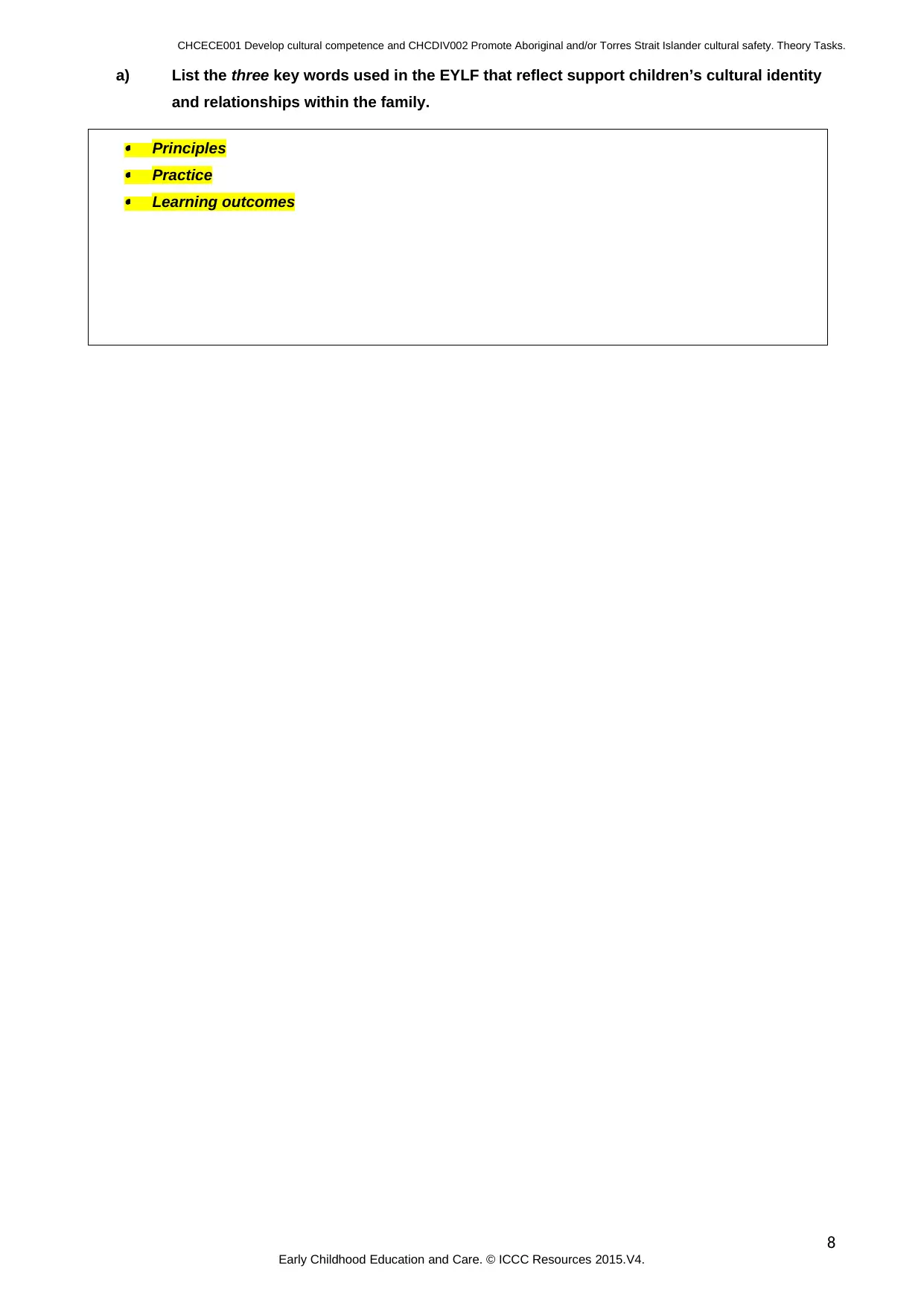
CHCECE001 Develop cultural competence and CHCDIV002 Promote Aboriginal and/or Torres Strait Islander cultural safety. Theory Tasks.
a) List the three key words used in the EYLF that reflect support children’s cultural identity
and relationships within the family.
Principles Practice Learning outcomes
8
Early Childhood Education and Care. © ICCC Resources 2015.V4.
a) List the three key words used in the EYLF that reflect support children’s cultural identity
and relationships within the family.
Principles Practice Learning outcomes
8
Early Childhood Education and Care. © ICCC Resources 2015.V4.
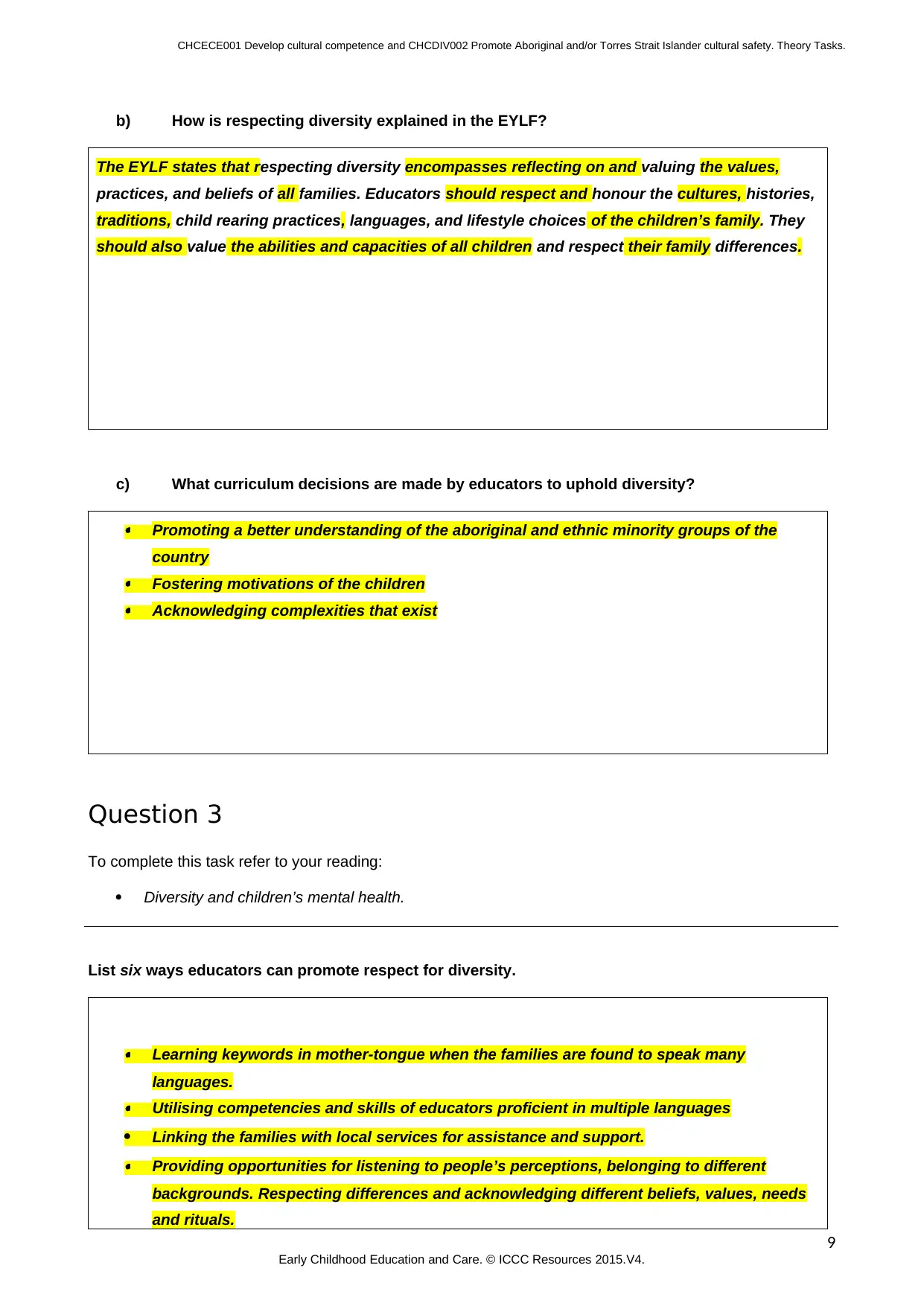
CHCECE001 Develop cultural competence and CHCDIV002 Promote Aboriginal and/or Torres Strait Islander cultural safety. Theory Tasks.
b) How is respecting diversity explained in the EYLF?
The EYLF states that respecting diversity encompasses reflecting on and valuing the values,
practices, and beliefs of all families. Educators should respect and honour the cultures, histories,
traditions, child rearing practices, languages, and lifestyle choices of the children’s family. They
should also value the abilities and capacities of all children and respect their family differences.
c) What curriculum decisions are made by educators to uphold diversity?
Promoting a better understanding of the aboriginal and ethnic minority groups of the
country Fostering motivations of the children Acknowledging complexities that exist
Question 3
To complete this task refer to your reading:
Diversity and children’s mental health.
List six ways educators can promote respect for diversity.
Learning keywords in mother-tongue when the families are found to speak many
languages. Utilising competencies and skills of educators proficient in multiple languages
Linking the families with local services for assistance and support. Providing opportunities for listening to people’s perceptions, belonging to different
backgrounds. Respecting differences and acknowledging different beliefs, values, needs
and rituals.
9
Early Childhood Education and Care. © ICCC Resources 2015.V4.
b) How is respecting diversity explained in the EYLF?
The EYLF states that respecting diversity encompasses reflecting on and valuing the values,
practices, and beliefs of all families. Educators should respect and honour the cultures, histories,
traditions, child rearing practices, languages, and lifestyle choices of the children’s family. They
should also value the abilities and capacities of all children and respect their family differences.
c) What curriculum decisions are made by educators to uphold diversity?
Promoting a better understanding of the aboriginal and ethnic minority groups of the
country Fostering motivations of the children Acknowledging complexities that exist
Question 3
To complete this task refer to your reading:
Diversity and children’s mental health.
List six ways educators can promote respect for diversity.
Learning keywords in mother-tongue when the families are found to speak many
languages. Utilising competencies and skills of educators proficient in multiple languages
Linking the families with local services for assistance and support. Providing opportunities for listening to people’s perceptions, belonging to different
backgrounds. Respecting differences and acknowledging different beliefs, values, needs
and rituals.
9
Early Childhood Education and Care. © ICCC Resources 2015.V4.
⊘ This is a preview!⊘
Do you want full access?
Subscribe today to unlock all pages.

Trusted by 1+ million students worldwide
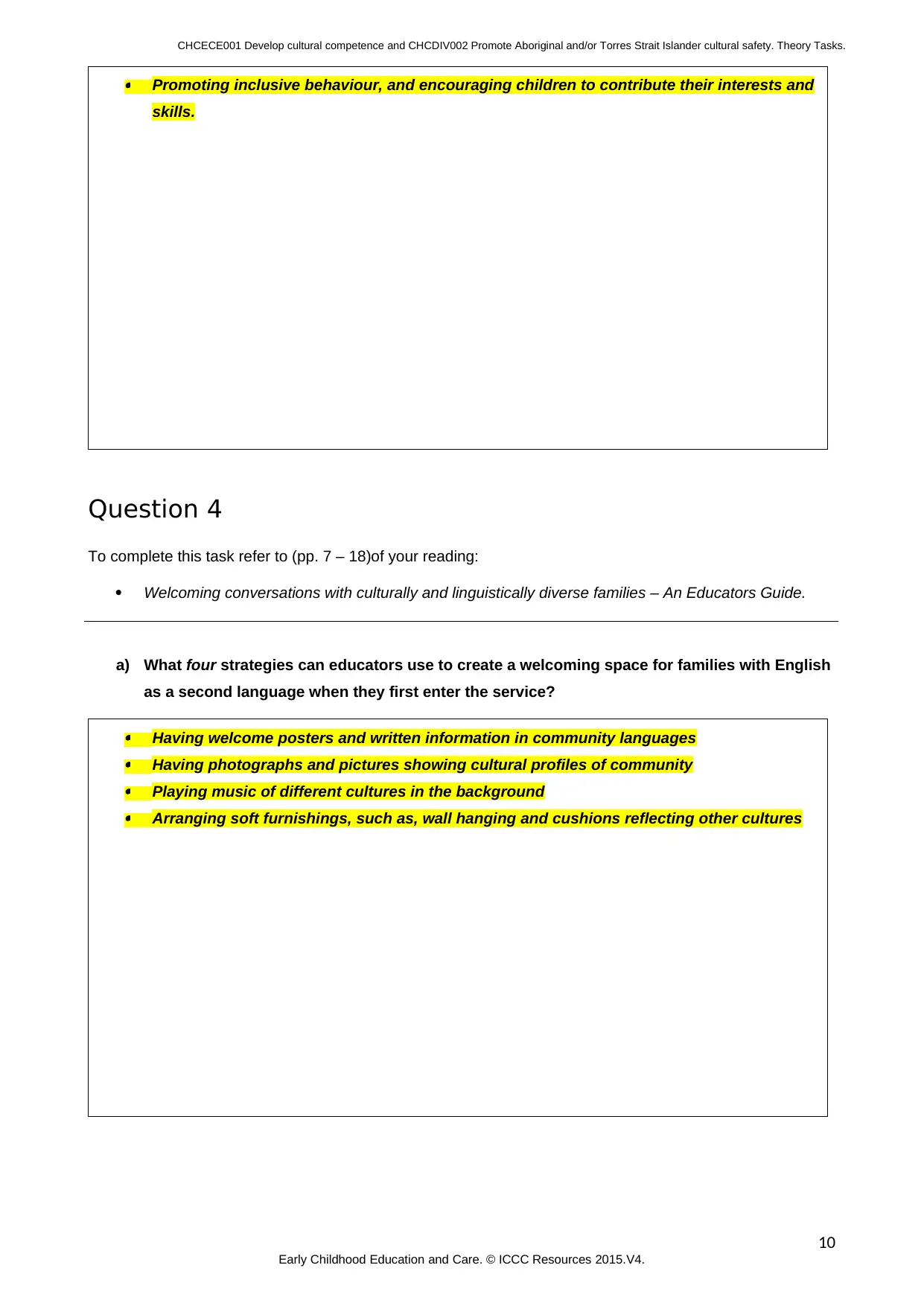
CHCECE001 Develop cultural competence and CHCDIV002 Promote Aboriginal and/or Torres Strait Islander cultural safety. Theory Tasks.
Promoting inclusive behaviour, and encouraging children to contribute their interests and
skills.
Question 4
To complete this task refer to (pp. 7 – 18)of your reading:
Welcoming conversations with culturally and linguistically diverse families – An Educators Guide.
a) What four strategies can educators use to create a welcoming space for families with English
as a second language when they first enter the service?
Having welcome posters and written information in community languages Having photographs and pictures showing cultural profiles of community Playing music of different cultures in the background Arranging soft furnishings, such as, wall hanging and cushions reflecting other cultures
10
Early Childhood Education and Care. © ICCC Resources 2015.V4.
Promoting inclusive behaviour, and encouraging children to contribute their interests and
skills.
Question 4
To complete this task refer to (pp. 7 – 18)of your reading:
Welcoming conversations with culturally and linguistically diverse families – An Educators Guide.
a) What four strategies can educators use to create a welcoming space for families with English
as a second language when they first enter the service?
Having welcome posters and written information in community languages Having photographs and pictures showing cultural profiles of community Playing music of different cultures in the background Arranging soft furnishings, such as, wall hanging and cushions reflecting other cultures
10
Early Childhood Education and Care. © ICCC Resources 2015.V4.
Paraphrase This Document
Need a fresh take? Get an instant paraphrase of this document with our AI Paraphraser
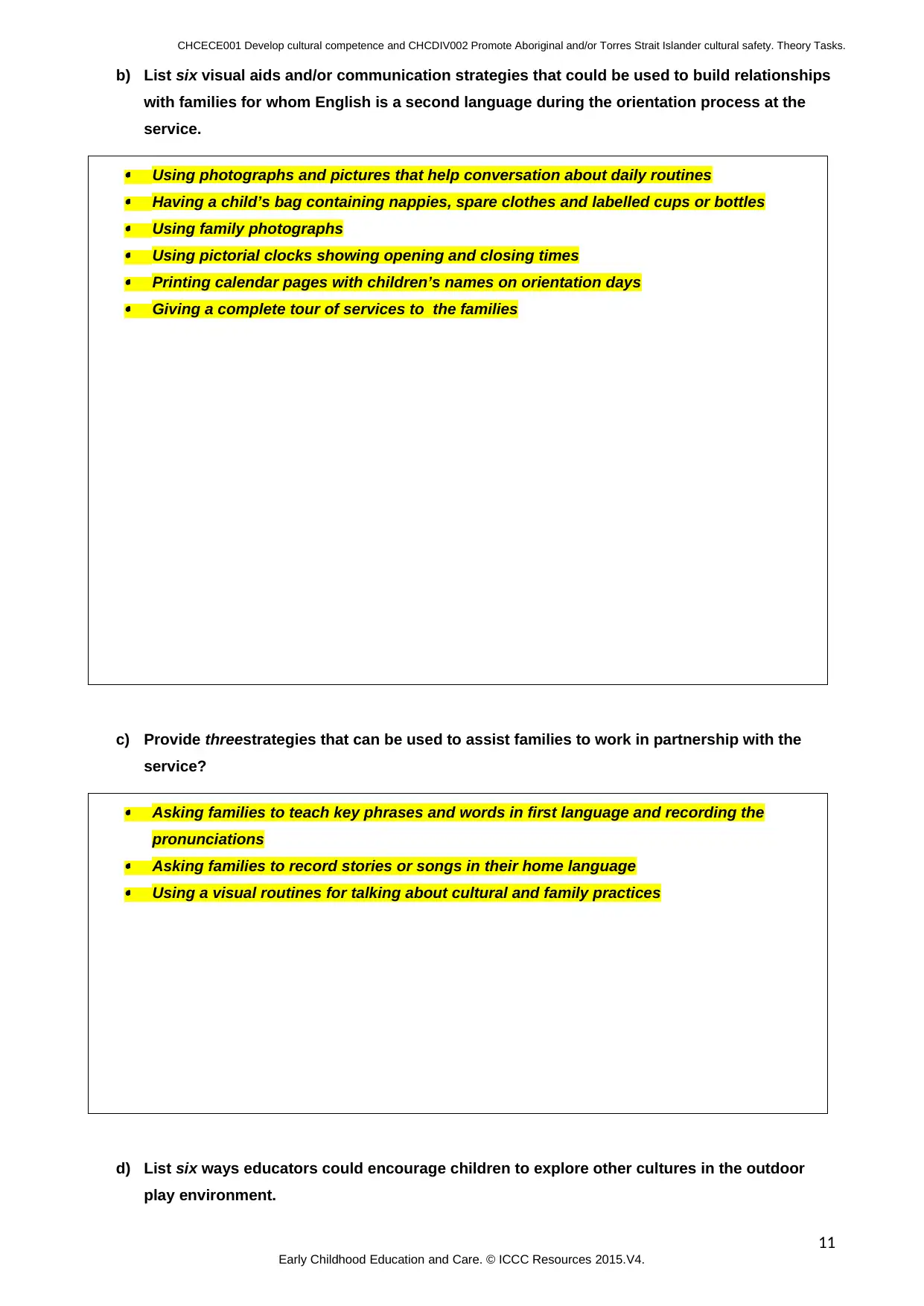
CHCECE001 Develop cultural competence and CHCDIV002 Promote Aboriginal and/or Torres Strait Islander cultural safety. Theory Tasks.
b) List six visual aids and/or communication strategies that could be used to build relationships
with families for whom English is a second language during the orientation process at the
service.
Using photographs and pictures that help conversation about daily routines Having a child’s bag containing nappies, spare clothes and labelled cups or bottles Using family photographs Using pictorial clocks showing opening and closing times Printing calendar pages with children’s names on orientation days Giving a complete tour of services to the families
c) Provide threestrategies that can be used to assist families to work in partnership with the
service?
Asking families to teach key phrases and words in first language and recording the
pronunciations Asking families to record stories or songs in their home language Using a visual routines for talking about cultural and family practices
d) List six ways educators could encourage children to explore other cultures in the outdoor
play environment.
11
Early Childhood Education and Care. © ICCC Resources 2015.V4.
b) List six visual aids and/or communication strategies that could be used to build relationships
with families for whom English is a second language during the orientation process at the
service.
Using photographs and pictures that help conversation about daily routines Having a child’s bag containing nappies, spare clothes and labelled cups or bottles Using family photographs Using pictorial clocks showing opening and closing times Printing calendar pages with children’s names on orientation days Giving a complete tour of services to the families
c) Provide threestrategies that can be used to assist families to work in partnership with the
service?
Asking families to teach key phrases and words in first language and recording the
pronunciations Asking families to record stories or songs in their home language Using a visual routines for talking about cultural and family practices
d) List six ways educators could encourage children to explore other cultures in the outdoor
play environment.
11
Early Childhood Education and Care. © ICCC Resources 2015.V4.
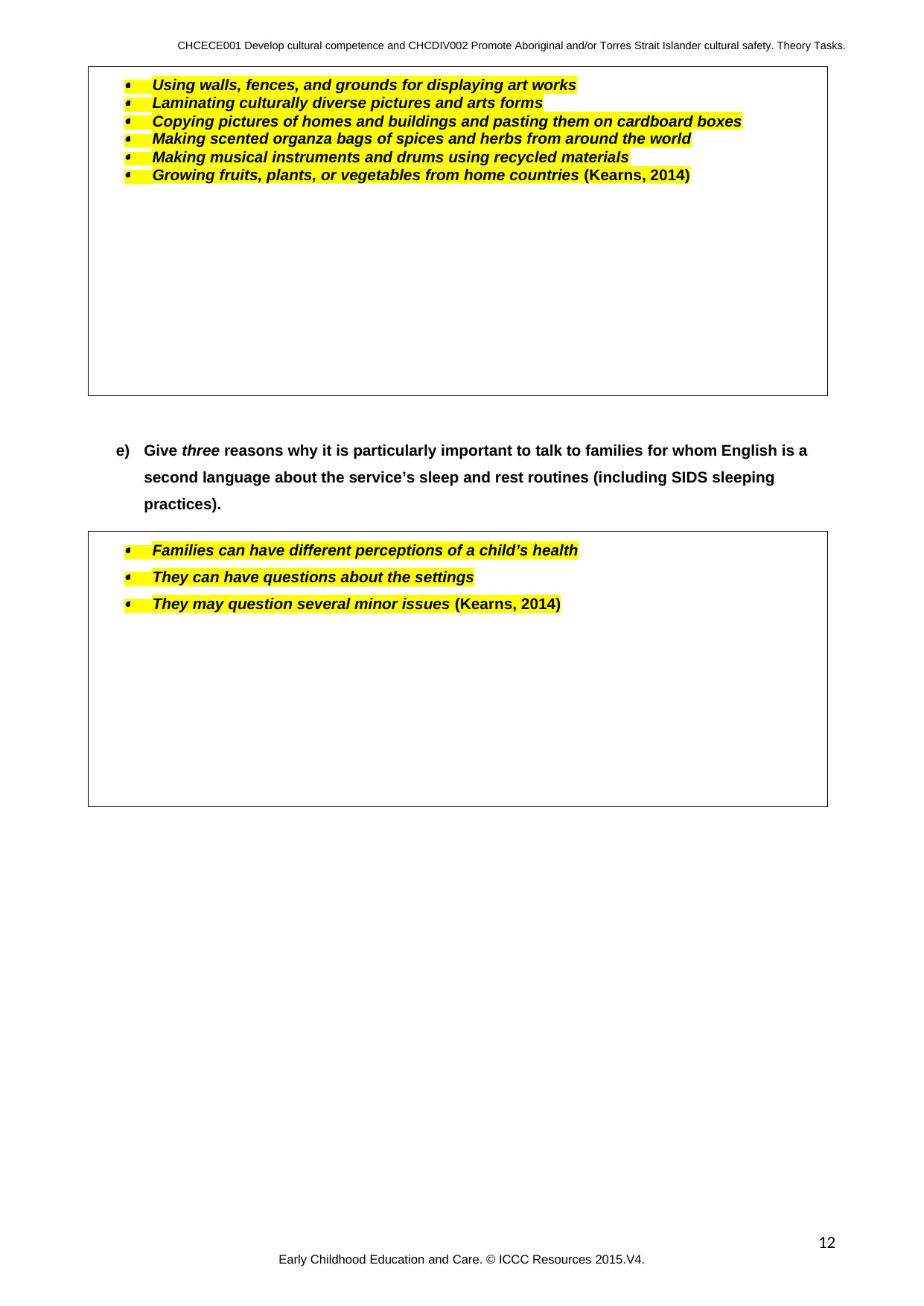
CHCECE001 Develop cultural competence and CHCDIV002 Promote Aboriginal and/or Torres Strait Islander cultural safety. Theory Tasks.
Using walls, fences, and grounds for displaying art works
Laminating culturally diverse pictures and arts forms
Copying pictures of homes and buildings and pasting them on cardboard boxes
Making scented organza bags of spices and herbs from around the world
Making musical instruments and drums using recycled materials
Growing fruits, plants, or vegetables from home countries (Kearns, 2014)
e) Give three reasons why it is particularly important to talk to families for whom English is a
second language about the service’s sleep and rest routines (including SIDS sleeping
practices).
Families can have different perceptions of a child’s health They can have questions about the settings They may question several minor issues (Kearns, 2014)
12
Early Childhood Education and Care. © ICCC Resources 2015.V4.
Using walls, fences, and grounds for displaying art works
Laminating culturally diverse pictures and arts forms
Copying pictures of homes and buildings and pasting them on cardboard boxes
Making scented organza bags of spices and herbs from around the world
Making musical instruments and drums using recycled materials
Growing fruits, plants, or vegetables from home countries (Kearns, 2014)
e) Give three reasons why it is particularly important to talk to families for whom English is a
second language about the service’s sleep and rest routines (including SIDS sleeping
practices).
Families can have different perceptions of a child’s health They can have questions about the settings They may question several minor issues (Kearns, 2014)
12
Early Childhood Education and Care. © ICCC Resources 2015.V4.
⊘ This is a preview!⊘
Do you want full access?
Subscribe today to unlock all pages.

Trusted by 1+ million students worldwide
1 out of 68
Related Documents
Your All-in-One AI-Powered Toolkit for Academic Success.
+13062052269
info@desklib.com
Available 24*7 on WhatsApp / Email
![[object Object]](/_next/static/media/star-bottom.7253800d.svg)
Unlock your academic potential
Copyright © 2020–2025 A2Z Services. All Rights Reserved. Developed and managed by ZUCOL.





